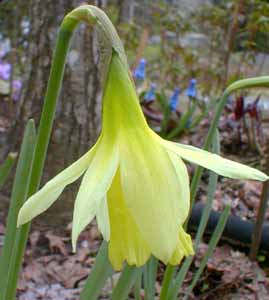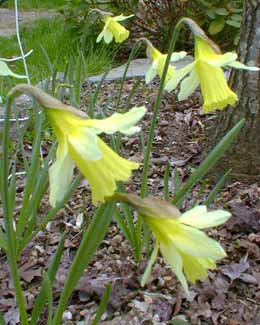
Milner's Miniature
Trumpet Daffodil
"Under the orchard trees daffodils danced
And jostled, turning sideways to the wind.
A dropping cherry petal softly glanced
Over her hair, and slid away behind."
-Amy Lowell,
Figurines in Old Saxe Pickthorn Manor
Figurines in Old Saxe Pickthorn Manor
That autumn of (if I recall) 2003, Granny Artemis hand-selected five of these narcissus bulbs in order to get only double-bulbs which made them seem as though they were half price. A couple of autumns later, we added five more bulbs. The bulbs are rather big considering that 'W. P. Milner' is a true dwarf in the six to eight inch range of height & sometimes shorter.
Most years blooming for us in March & early April, our 2006 winter was warm & wet, & 'Milner' was blooming by February. We then had an untimely "arctic front" week with temperatures in the upper 'twenties, which shocked many a plant that had gotten ahead of schedule, but did not hinder 'Milner' or any other early blooming narcissus one whit.
 The smallish but very bright blooms are just barely bicolors. There is a creamy, mauve, or straw color to the petals. Much of the color at the petal tips fades to ivory as the blossom ages. The trumpets are sulfur-yellow, sometimes with a greenish hue. It is often repeated that these faintly scented blooms are "elfin" or "cowslip-like."
The smallish but very bright blooms are just barely bicolors. There is a creamy, mauve, or straw color to the petals. Much of the color at the petal tips fades to ivory as the blossom ages. The trumpets are sulfur-yellow, sometimes with a greenish hue. It is often repeated that these faintly scented blooms are "elfin" or "cowslip-like."The petals sweep forward a little as if eager to embrace the trumpet, & each petal twists a bit like a whirligig propellor, giving the bloom quite a unique look, not easily mistaken for other miniature daffodils.
The whole bloom bows its head as to pray. It looks best with bulbs that flower blue (we have it with grape hyacinths) or purple (crocus for instance, though in our zone crocuses are reaching the end of their prime as narcissi are erupting). The grape hyacinths have helped to enhance the faint & fading yellows, whereas with much yellower narcissi, 'Milner' may seem merely white & not show its actually unique coloration to best effect.
The reason catalogs have contradictory statements about its color is because it will be whiter if grown in warmer southern gardens or forced indoors, but will keep more of the sulfer in northerly gardens like ours.
'W. P. Milner' naturalizes easily in a sunny spot that is moist in spring & dryish during the bulbs' summer dormancy. It is an heirloom variety dating to no later than 1869, having been introduced by pioneer English hybridizer Henry Backhouse (1849-1936).
It is probably the oldest miniature daffodil continuously gardened from Victorian times to the present, no newer cultivars having proven themselves so much better as to displace 'W. P. Milner.' The fact that it is one of the sturdiest miniatures just about guaranteed to come back year after year & never be tippy keeps its appeal high.
Even though it tends to naturalize like a botanical daffodil, it is actually a Trumpet division hybrid of uncertain species. A Holland grower ventures that it is derived in part from N. triandrus ssp triandrus, or Angel Tears daffodil, but it is nevertheless categorized as a Trumpet hybrid rather than in the Triandrus group.